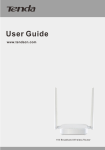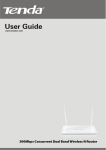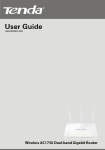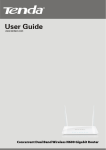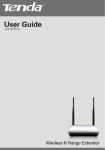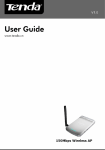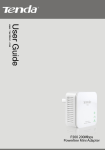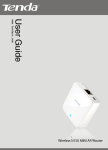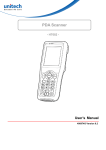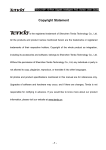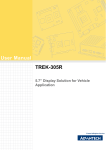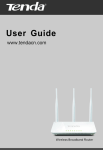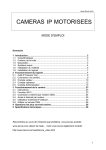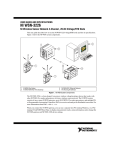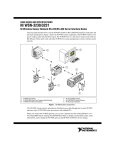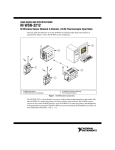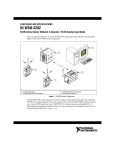Download Tenda 4G630 router
Transcript
Copyright Statement is the registered trademark of Shenzhen Tenda Technology Co., Ltd. All the products and product names mentioned herein are the trademarks or registered trademarks of their respective holders. Copyright of the whole product as integration, including its accessories and software, belongs to Shenzhen Tenda Technology Co., Ltd. No part of this publication can be reproduced, transmitted, transcribed, stored in a retrieval system, or translated into any language in any form or by any means without the prior written permission of Shenzhen Tenda Technology Co., Ltd. If you would like to know more about our product information, please visit our website at http://www.tendacn.com. Disclaimer Pictures, images and product specifications herein are for references only. To improve internal design, operational function, and/or reliability, Tenda reserves the right to make changes to the products described in this document without obligation to notify any person or organization of such revisions or changes. Tenda does not assume any liability that may occur d ue to the use or application of the product or circuit layout(s) described herein. Every effort has been made in the preparation of this document to e nsure accuracy of the contents, but all statements, information and recommendations in this document do not constitute the warranty of any kind, express or implied. I About this Manual Thank you for choosing Tenda! Before you start , please read this User Guide, which instructs you to install and configure your device . This User Guide is applicable to 4G600 and 4G630. Unless otherwise specified, the 4G630 is used as an example throughout this User Guide. Convention This user guide uses the following formats to high light special messages: Icon Description This format is used to highlight information of importance or special interest. Ignoring this type Note of note may result in ineffective configurations, loss of data or damage to device. This format is used to highlight a procedure that Tip will save time or resources. Knowledge Center Description of fields on the device GUI. Technical Support II Website: http://www.tendacn.com Email: [email protected] Skype: tendasz YouTube: Tendasz1999 Hotline: 1-800-570-5892 (USA) (061) 1300787922 (Australia) (064) 800787922 (New Zealand) (0852) 36120883 (Hong Kong) Contents About this M anual .......................................................................................................... II Convention ..................................................................................................................... II Technical Support ........................................................................................................... II I Product Overview .......................................................................................................... 1 1 Package Contents ......................................................................................................... 1 2 Getting to Kno w Your Device ....................................................................................... 1 2.1 What It Looks like .................................................................................................. 1 2.2 LED ....................................................................................................................... 2 2.3 Button & Inter face .................................................................................................. 3 2.4 Label ..................................................................................................................... 4 II Quick Setup ................................................................................................................. 5 1 Hard ware Install .......................................................................................................... 5 3G/4G Router Mode ..................................................................................................... 5 Wireless Router Mode .................................................................................................. 6 Universal Repeater Mode ............................................................................................. 7 2 Configure Your PC ....................................................................................................... 7 3 Web Login ................................................................................................................... 8 4 Quick Internet Setup & Wireless Security Setup ............................................................ 9 3G/4G Router Mode .................................................................................................... 10 Wireless Router Mode – DHCP .................................................................................... 12 Wireless Router Mode – PPPoE ................................................................................... 13 Universal Repeater Mode ............................................................................................ 15 Auto-switch System Mode & Priority ........................................................................... 17 III Features & Conf igurations ........................................................................................ 19 1 Status ......................................................................................................................... 19 WAN Status ................................................................................................................ 19 LAN Status ................................................................................................................. 21 Wireless Status ........................................................................................................... 21 System Status ............................................................................................................. 22 2 Basic Settings ............................................................................................................. 23 2.1 LAN Settings ........................................................................................................ 23 2.2 WAN Settings ........................................................................................................ 24 2.3 WAN Speed (Availab le only in Wireless Router Mode) ............................................ 32 2.4 DNS Settings ........................................................................................................ 33 2.5 MAC Clone (Available only in Wireless Router Mode) ............................................ 34 2.6 DHCP Server ......................................................................................................... 36 2.7 DHCP Client List .................................................................................................. 37 3 Wireless Settings ........................................................................................................ 40 3.1 Basic .................................................................................................................... 40 3.2 Security ................................................................................................................ 41 3.3 Access Control ...................................................................................................... 44 3.4 Connection Status .................................................................................................. 45 III 4 Advanced Applications ................................................................................................ 47 4.1 DDNS Settings ...................................................................................................... 47 4.2 DMZ Host ............................................................................................................. 50 4.3 UPNP .................................................................................................................... 51 4.4 Remote Web Management ...................................................................................... 52 4.5 Band width Control (Available only in 4G600) ........................................................ 53 4.6 Client Filter (Availab le only in 4G600) .................................................................. 55 5 Tools .......................................................................................................................... 59 5.1 Time & Date ......................................................................................................... 59 5.2 Firmware Upgrade ................................................................................................. 61 5.3 Backup & Restor e.................................................................................................. 62 5.4 Restore to Factor y Default ..................................................................................... 65 5.5 Change Password ................................................................................................... 66 5.6 Logs ..................................................................................................................... 67 5.7 Reboot .................................................................................................................. 68 IV Appendix .................................................................................................................... 69 1 Configure Your PC ...................................................................................................... 69 Windo ws 7 .................................................................................................................. 69 Windo ws XP ............................................................................................................... 71 2 Join Your Wireless Network ......................................................................................... 74 Windo ws 7 .................................................................................................................. 74 Windo ws XP ............................................................................................................... 75 3 FAQs .......................................................................................................................... 78 4 Remo ve Wireless Network fro m Your PC ...................................................................... 80 Windo ws 7 .................................................................................................................. 80 Windo ws XP ............................................................................................................... 81 5 Safety and Emission Statement .................................................................................... 83 IV I Product Overview 1 Package Contents Unpack the package. Your box should contain the following items: 3G/4G W ireless Router Ethernet Cable Power Adapter Install Guide Resource CD If any of the parts are incorrect, missing, or damaged, contact your Tenda dealer. Keep the carton, including the original packing materials, in case you need to return the product for repair. 2 Getting to Know Your Device 2.1 What It Looks like 4G630 1 I Product Overview | Tenda 4G600 2.2 LED LED 2 Status Description PW R Solid The device is receiving electric power. SYS Blinking System is starting up properly. WPS Blinking The device is functioning properly. I Product Overview | Tenda The WAN/LAN /W LAN interface is transmitting Blinking data. WAN/LAN/W iFi The WAN/LAN interface is connected correctly. Solid The W iFi radio is on. USB Solid The USB port is connected correctly. This icon indicates no actual meaning. It is only for / decoration. 2.3 Button & Interface Button/Interface USB Description USB port for attaching a 3G/4G USB Modem Pressing this button for over 6 seconds resets the WPS/Reset device to factory default settings or 1-3 seconds to enable W PS quick encryption. 3 WAN Internet port for cabling the device to the Internet side LAN1/2/3 Local (LAN) Ethernet ports for cabling the device to I Product Overview | Tenda local computers, switches, etc. POW ER Power port for connecting the device to a power outlet 2.4 Label 1→Product Model 2→Default Login IP address This IP address is to be used to access the device’s settings through a Web browser. 3/4→Default login user name/password This information is to be used for web access authentication . 5→Device’s physical address 4 I Product Overview | Tenda II Quick Setup 1 Hardware Install You can either connect to the device wirelessly or using Ethernet cables. Select an install method according to your network environment. A. If you access the Internet via a 3G/4G USB modem, see 3G/4G Router Mode. B. If you access the Internet by connecting the device to the Ethernet cable from the incoming Internet side, see Wireless Router Mode. C. If you acquire Internet access from a remote AP on an existing netwo rk, see Universal Repeater Mode. Note ① DO NOT expose the device to heat sources . ② Disconnect the device from power supply in thunderstorm weather. ③ Keep the device away from electrical appliances (such as electromagnetic cooker and cordless phone, etc .) to avoid electromagnetic interference . 3G/4G Router Mode By connecting an activated 3G/4G USB modem to your device and it gives you the freedom to roam while staying connected to the Internet. ① Insert a 3G/4G USB modem to the device. ② Connect the device to a power outlet. ③ Connect your desktop, notebook and smart phone, etc. to the device. 5 II Quick Setup | Tenda Wireless Router Mode In this mode, your device functions as a common wireless router. Simply connect it to an Internet-enabled DSL/fiber optical/cable modem. ① Connect the WAN port of the device to an Internet-enabled DSL/fiber optical/cable modem. ② Connect the modem and the device to a power outlet. ③ Connect your desktop, notebook and smart phone to the device. 6 II Quick Setup | Tenda Universal Repeater Mode The universal repeater feature can be used to extend your existing wireless network coverage. ① Connect the device to a power outlet. ② Connect your desktop, notebook and smart phone to the device. Tip ① To scan and connect to a remote wireless device see Universal Repeater Mode in 4 Quick Internet Setup & Wireless Security Setup . ② To connect the device wirelessly, see 2 Join Your W ireless Network . 2 Configure Your PC If your computer is set to a static or fixed IP address ( This is uncommon), change it to "Obtain an IP address automatically" and "Obtain DNS server address automatically" from the device. See 1 Configure Your PC. 7 II Quick Setup | Tenda 3 Web Login ① Launch a Web browser, say, IE. ② In the address bar, input the device’s LAN IP address ( 192.168.0.1 by default), and press Enter. ③ Enter the login password (admin by default) and click Login. ④ The Status screen appears. Click Wizard to enter the setup wizard interface. 8 II Quick Setup | Tenda 4 Quick Internet Setup & Wireless Security Setup Read the following and determine your Internet connection type. Then follow the right setup wizard. A. If you access the Internet via a 3G/4G USB modem, see 3G/4G Router 9 II Quick Setup | Tenda Mode. B. If your ISP provides you with a cable from the incoming Internet side but no ISP login account or IP information, your ISP uses a DHCP connection. See Wireless Router Mode – DHCP. C. If your ISP provides you with a cable from the incoming Internet side and a PPPoE login account, your ISP uses a PPPoE connection. See Wireless Router Mode – PPPoE. D. If you acquire Internet access from a remote AP on an existing network , see Universal Repeater Mode. E. To learn about the Auto-switch System Mode, 3G/4G Priority and/or Ethernet Priority, see Auto-switch System Mode & Priority. 3G/4G Router Mode ① Select 3G/4G Router Mode and click Next. ② Configure 3G/ 4G Internet connection settings and then click Next. If you are not sure of which service provider to use, select Auto. 10 II Quick Setup | Tenda ③ Configure your wireless network: SSID, Channel, Key and then click Next. ④ Click Finish and wait for the device to restart. 11 II Quick Setup | Tenda Wireless Router Mode – DHCP ① Select Wireless Router Mode and click Next. ② Select DHCP and click Next. ③ Configure your wireless network: SSID, Channel, Key and then click Next. 12 II Quick Setup | Tenda ④ Click Finish and wait for the device to restart. Wireless Router Mode – PPPoE ① Select Wireless Router Mode and click Next. 13 II Quick Setup | Tenda ② Select PPPoE, enter the PPPoE User Name/Password and click Next. ③ Configure your wireless network: SSID, Channel, Key and then click Next. 14 II Quick Setup | Tenda ④ Click Finish and wait for the device to restart. Tip Five Internet connection types are supported for the wired WAN connection (Ethernet): DHCP, PPPOE, PPTP, L2TP and Static IP. For PPTP, L2TP and Static IP, see 2.2 WAN Settings. Universal Repeater Mode ① Select Universal Repeater Mode and click Next. 15 II Quick Setup | Tenda ② Enter or select the SSID, MAC, Channel and security settings exactly the same as the remote AP and then click Next. ③ Configure your wireless network: SSID and Key and then click Next. 16 II Quick Setup | Tenda ④ Click Finish and wait for the device to restart. Tip In Universal Repeater Mode, your wireless network must operate on the same channel as the remote AP. Auto-switch System Mode & Priority Auto-switch System Mode: If unchecked, system will not switch between the 3G/4G Router Mode and Wireless Router Mode. If the Auto-switch System Mode and 3G/4G Priority are selected , system will: 17 prioritize the 3G/4G Router Mode when detecting the coexistence of an II Quick Setup | Tenda Ethernet cable and a 3G/4G USB modem. operate in the 3G/4G Router Mode when only detecting a 3G/4G USB modem. toggle to the Wireless Router Mode when only detecting an Ethernet cable. If the Auto-switch System Mode and Ethernet Priority are selected , system will: prioritize the Wireless Router Mode when detecting the coexistence of an Ethernet cable and a 3G/4G USB modem. toggle to the 3G/4G Router Mode when only detecting a 3G/4G USB modem. operate in the Wireless Router Mode when only detecting an Ethernet cable. 18 II Quick Setup | Tenda III Features & Configurations 1 Status Click Status to enter the Status screen. WAN Status WAN Status in 3G/4G Router Mode: 3G/4G Traffic Statistics To view the 3G/4G traffic statistics, click Status -> 3G/4G Traffic Statistics. This screen is available only in the 3G/4G Router Mode. 19 III Features & Configurations | Tenda WAN Status in Wireless Router Mode WAN Status in Universal Repeater Mode 20 III Features & Configurations | Tenda Tip ① WAN IP/Subnet Mask/Gateway/Primary DNS Server/Secondary DNS Server: This type of information appears only if the router suc cessfully connects to the Internet via a PPPoE or a DHCP (dynamic IP) connection. However if you connect the router to the Internet with static IP settings provided by your ISP, these fields will display the settings you entered whether the router successf ully connects to the Internet or not. ② If there is no available secondary DNS server, nothing appears in the secondary DNS server field . LAN Status Note The DHCP Server is disabled in Universal Repeater Mode. Wireless Status 21 III Features & Configurations | Tenda System Status Knowledge Center WAN MAC Address: The device’s current WAN MAC address. System Time: Current system time on this device. The device automatically synchronizes the system time with Internet time servers. Up Time: Displays the time duration indicating how long t he router has been up since startup. Up time is recounted and renewed upon power -off. Connected Clients: Displays the number of DHCP clients. 22 III Features & Configurations | Tenda 2 Basic Settings To change the device's login IP address, see 2.1 LAN Settings. To set up the Internet, see 2.2 WAN Settings. To set up speed and duplex mode for the WAN port, see 2.3 WAN Speed (Available only in Wireless Router Mode) . To configure DNS server, see 2.4 DNS Settings. To clone MAC address, see 2.5 MAC Clone (Available only in Wireless Router Mode). To configure DHCP server, see 2.6 DHCP Server. To assign static IP addresses and view LAN device information, see 2.7 DHCP Client List. Note In the Universal Repeater Mode, only the LAN Settings screen is available. 2.1 LAN Settings Here you can configure the LAN IP address and subnet mask. This IP address is to be used to access the device’s settings through a Web browser. Be sure to make a note of any changes you apply to this page. Tip ① Default IP address and subnet mask are respec tively 192.168.0.1 and 255.255.255.0. ② If you change the LAN IP address of the device, you have to open a new connection to the new IP address and log in again. Also, you have to set the default gateway addresses of all LAN PCs to this new IP address. ③ The device's LAN IP address and WAN IP address must be on different IP 23 III Features & Configurations | Tenda segments. If not, it will not be able to access the Internet. Configuration Procedures: ① Change the IP address to the one you wish to use, for example, 192.168.10.1. ② Click Save to save your settings. 2.2 WAN Settings Click Basic -> WAN Settings to configure your Internet connection settings. 3G/4G Router Mode 24 III Features & Configurations | Tenda Configuration Procedures: ① Country: Select your country. ② Service Provider/ISP: Select your 3G/4G service provider and ISP. ③ APN: Access point Name. Consult your ISP if you are not clear. ④ Dial Number: Common numbers are *99#, #777 and *99***1. Consult your ISP if you are not clear. ⑤ User Name/Password: Enter the user name and password for your 3G/4G Internet service. ⑥ Click Save. Knowledge Center Connect Automatically: Connect automatically to the Internet after rebooting the system or connection failure. 25 III Features & Configurations | Tenda Connect Manually: Require the user to manually connect to the Internet before each session. Connect On Demand: Re-establish connection to the Internet only when there is data transmitting. Connect During Specified Time Period: Connect automatically to the Internet during a specified time length. Wireless Router Mode The Wireless Router Mode includes the following Internet connection typ es: DHCP PPPoE Static IP L2TP PPTP A. Select PPPoE if your ISP uses a PPPoE c onnection and gives you a PPPoE user name and a PPPoE password. B. Select Static IP if your ISP provides you with fixed or static IP address settings (special deployment by ISP; this is rare). C. Select DHCP (Dynamic IP) if your ISP does not provide you with any ISP login account or IP information. D. Select L2TP (Layer 2 Tunneling Protocol) if your ISP uses an L2TP connection. E. Select PPTP (Point -to-Point-Tunneling Protocol) if your ISP uses a PPTP connection. DHCP DHCP or Dynamic IP is a connection mode that allow s the device to automatically acquire IP information from your ISP or your existing networking equipment. 26 III Features & Configurations | Tenda Configuration Procedures: ① Internet Connection Type: Select DHCP. ② Click Save to save your settings. PPPoE PPPoE is a connection mode associated with some DSL connections that requires user name and password. Contact your ISP if you need assistance with these login credentials. Configuration Procedures: ① Internet Connection Type: Select PPPoE. 27 III Features & Configurations | Tenda ② User Name: Enter the ISP login name. ③ Password: Enter the ISP login password. ④ Click Save to save your settings. Knowledge Center MTU: The MTU (maximum transmission unit) is the largest data packet a network device transmits. The normal MTU value for most Ethernet networks is 1500 bytes, or 1492 bytes for PPPoE co nnections. For some ISPs, you might need to change the MTU. This is rarely required, and should not be done unless you are sure it is necessary for your ISP connection. For more information, see WAN MTU Setup. Static IP Static IP is a connection mode that allows you to specify the Static IP information provided by your ISP or that corresponds with your existing networking equipment. Configuration Procedures: ① Internet Connection Type: Select Static IP. 28 III Features & Configurations | Tenda ② IP Address/Subnet Mask/Gateway/Primary DNS/Secondary DNS: Enter the information provided by your ISP. ③ Click Save to save your settings. L2TP L2TP (Layer 2 Tunneling Protocol) is a network protocol that enables the secure transfer of data from a remote client to a private en terprise server by creating a VPN across TCP/IP-based data. Enter your ISP provided information to establish a connection. Configuration Procedures: ① Internet Connection Type: Select L2TP. ② L2TP Server Address: E n t e r t h e L 2 T P I P a d d r e s s p r o v i d e d b y y o u r I S P. ③ U s e r Na m e : E n t e r y o u r L 2 T P u s e r n a m e . ④ Password: Enter your L2TP Password. ⑤ A d d r e s s M o d e : S e l e c t D y n a m i c i f y o u d o n ’ t g e t a n y I P i n f o rmation f r o m y o u r I S P, o t h e r w i s e s e l e c t S t a t i c . C o n s u l t y o u r I S P i f y o u a r e 29 III Features & Configurations | Tenda n o t c l e a r. ⑥ I P A d d r e s s : E n t e r t h e I P a d d r e s s p r o v i d e d b y y o u r I S P. C o n s u l t y o u r l o c a l I S P i f y o u a r e n o t c l e a r. ⑦ Subnet Mask: E n t e r t h e subnet mask. ⑧ G a t e w a y : E n t e r t h e g a t e w a y p r o v i d e d b y y o u r I S P. C o n s u l t y o u r l o c a l I S P i f y o u a r e n o t c l e a r. ⑨ Click Save to save your settings. PPTP PPTP (Point-To-Point Tunneling Protocol) is a network protocol that enables the secure transfer of data from a remote client to a private enterprise server by creating a VPN across TCP/IP -based data. Enter your ISP provided information to establish a connection. MPPE is an encryption technology developed point-to-point links. Configuration Procedures: ① Internet Connection Type: Select PPTP. 30 III Features & Configurations | Tenda by Microsoft to encrypt ② PPTP Server Address: E n t e r t h e PPTP I P a d d r e s s p r o v i d e d b y y o u r I S P. ③ U s e r Na m e : E n t e r y o u r PPTP u s e r n a m e . ④ P a s s w o r d : E n t e r y o u r PPTP pa s s w o r d . ⑤ A d d r e s s M o d e : S e l e c t D y n a m i c i f y o u d o n ’ t g e t a n y I P i n f o rmation f r o m y o u r I S P, o t h e r w i s e s e l e c t S t a t i c . C o n s u l t y o u r I S P i f y o u a r e n o t c l e a r. ⑥ I P A d d r e s s : E n t e r t h e I P a d d r e s s p r o v i d e d b y y o u r I S P. C o n s u l t y o u r l o c a l I S P i f y o u a r e n o t c l e a r. ⑦ Subnet Mask: E n t e r t h e subnet mask. ⑧ G a t e w a y : E n t e r t h e g a t e w a y p r o v i d e d b y y o u r I S P. C o n s u l t y o u r l o c a l I S P i f y o u a r e n o t c l e a r. ⑨ Click Save to save your settings. WAN MTU Setup The MTU (maximum transmission unit) is the largest data pack et a network device transmits. The normal MTU value for most Ethernet networks is 1500 bytes, or 1492 bytes for PPPoE connections. For some ISPs, you might need to change the MTU. This is rarely required, and should not be done unless you are sure it is necessary for your ISP connection. W hen one network device communicates across the Internet with another, the data packets travel through many devices along the way. If a device in the data path has a smaller MTU value than the other devices, the data packets have to be "fragmented" to accommodate the device with the smallest MTU value. The best MTU value is often just the factory default value. In some situations, changing the MTU value fixes one problem but causes another. Leave the MTU unchanged unless one of these situations occurs: A. You have problems connecting to your ISP or other Internet service, and either your ISP or our technical support suggests changing the MTU value. Below Web-based applications might require an MTU change: 31 A secure Website that does not open, or displays only part of a Web III Features & Configurations | Tenda page Yahoo email MSN portal B. You use VPN and encounter serious performance problems. C. You used a program to optimize MTU for performance reasons, and now you have connectivity or performance problems. If you suspect an MTU problem, try changing the MTU to 1400. If this does not help, gradually reduce the MTU from the maximum value of 1500 until the problem disappears. The common MTU sizes and applications are listed in the table below. MTU Application 1500 Typical for connections that do not use PPPoE or VPN. 1492 Used in PPPoE environments. Maximum size to use for pinging. (Larger packets are 1472 fragmented.) 1468 Used in some DHCP environments. 1436 Used in PPTP environments or with VPN. Note A wrong/improper MTU value may cause Internet communication problems. For example, you may be unable to access certain Websites, frames within Websites, secure login pages, FTP or POP servers. 2.3 WAN Speed (Available only in Wireless Router Mode) Click Basic -> WAN Speed to enter the configuration interface. Here you can configure the WAN speed and duplex mode. 32 III Features & Configurations | Tenda Tip ① The device operates in Auto (Auto-negotiation) mode by default. Usually, it works for most cases. ② In some situations, you might need to change the speed/duplex mode. For example, if the cable connected to your device's WAN port is longer than 100m, you may need to use 10M full -duplex or 10M half-duplex for better performance. Ensure that your device's WAN port operates with the same speed and duplex mode as the remote link partner. Otherwise, your device's WAN port may not receive and send data. 2.4 DNS Settings Click Basic -> DNS Settings to enter the configuration interface. 33 III Features & Configurations | Tenda Configuration Procedures: ① DNS Settings: Check/uncheck to enable/disable the DNS settings. ② Primary DNS Address: Enter the IP address of the primary DNS server provided by your ISP. ③ Secondary DNS Address: If a secondary DNS server address is available, enter it here. This field is optional. ④ Click Save to save your settings. Note The default DNS settings are recommended. Only change the DNS default settings if you know that your ISP requires specific servers. If incorrect DNS settings are configured, Webpages may not open. 2.5 MAC Clone (Available only in Wireless Router Mode) Some ISPs (Internet Service Providers) require end -user's MAC address to access their network. This feature copies your current PC's MAC address to the device. Click Basic -> MAC Clone to enter the configuration screen. 34 III Features & Configurations | Tenda Knowledge Center Restore Default MAC: Reset the device’s WAN MAC address to factory default. Clone MAC: Clicking this button copies the MAC address of the computer that you are currently using to the router. Note that you have to use the computer whose MAC address is allowed by your ISP. Also, you can manually enter the MAC address that you want to use. To restore default MAC address: ① Click Restore Default MAC. ② Click Save to save your settings. To copy the MAC address of the computer that you are currently using to the device: ① Click Clone MAC. ② Click Save to save your settings. To manually enter the M AC address allowed by your ISP: ① Enter the MAC address allowed by your ISP. ② Click Save to save your settings. 35 III Features & Configurations | Tenda 2.6 DHCP Server DHCP (Dynamic Host Configuration Protocol) assigns an IP addr ess to each device on the LAN/private network. W hen you enable the DHCP Server, the DHCP Server will automatically allocate an unused IP address from the IP address pool specified in this screen to the requesting device as long as the device is set to "Obtain an IP Address Automatically". If you disable this feature, you have to manually configure the TCP/IP settings for all PCs on your LAN to access the Internet. Click Basic -> DHCP Server to enter the screen below. Here you can change the DHCP IP address pool and lease time. Configuration Procedures: ① DHCP Server - Enable: Check/uncheck the box to enable or disable the DHCP server feature. ② Start IP/End IP: You can specify the starting and ending address es of the IP address pool here. These addresses shoul d be part of the same IP address subnet as the device’s LAN IP address. 36 III Features & Configurations | Tenda ③ Lease Time: The lease time is a time length that the IP address is assigned to each device before it is refreshed. ④ Click Save to save your settings. Tip ① By default, the device functions as a DHCP server. Do not disable the DHCP server feature unless you want to manually configure the TCP/IP settings for all the PCs on your LAN. ② Lease time will be renewed automatically upon expiry. ③ If you are not an advanced user, the default DHCP serv er settings are recommended. 2.7 DHCP Client List Click Basic -> DHCP Client List. Here you can see a list of the DHCP dynamic clients (if any). By viewing this list, you can know whether there are unauthorized accesses. Also, you can specify a reserved IP address for a PC on your LAN. That PC will always receive the same IP address each time when it accesses the DHCP 37 III Features & Configurations | Tenda server. Reserved IP addresses could be assigned to servers that require permanent IP settings. Static Assignment Application Example: To have a PC at the MAC address of 44:37:E6:4F:37:3 8 always receive the same IP address of 192.168. 0.123. Configuration Procedures: ① Enter the last number of the IP address you want to reserve . Here in this example, enter 123. ② Enter the MAC address of 44:37:E 6:4F:37:38. ③ Click Add. ④ Click Save to save your settings. Tip ① If the IP address you have reserved for your PC is currently used by another client, then you will not be able to obtain a new IP address from the device's DHCP server, instead, you must manual ly specify a different IP address for your PC to access the Internet. ② For PCs that have already obtained IP addresses, you may need to perform 38 III Features & Configurations | Tenda the Repair action to activate the configured static IP addresses. 39 III Features & Configurations | Tenda 3 Wireless Settings To configure wireless n etwork name, channel and other basic wireless settings, see 3.1 Basic. To secure your wireless network, see 3.2 Security. To restrict access to your wireless network, see 3.3 Access Control. To see who are connecting to your wireless network, see 3.4 Connection Status. 3.1 Basic Here you can configure the basic wireless settings of the device. Configuration Procedures: ① SSID: This is the public name of your wireless network. ② Channel: Select a channel or select Auto to let system automatically select one for your wireless network to operate on if you are unsure of which channel to use. The best selection is a channel that is the least used by neighboring networks. ③ Click Save to save your settings. 40 III Features & Configurations | Tenda Knowledge Center 802.11 Mode: Select a correct network mode according to your wireless clients. 11b mode: This network mode delivers wireless speed up to 11Mbps and is only compatible with 11b wireless clients. 11g mode: This network mode delivers wireless speed up to 54Mbps and is only compatible with 11g wireless clients. 11b/g mixed mode: This network mode delivers wireless speed up to 54Mbps and is compatible with 11b/g wireless clients. 11b/g/n mixed mode: This network mode delivers wireless speed up to 300Mbps and is compatible with 11b/g/n wireless clients. BSSID: This is the MAC address of the device's wireless interface. SSID Broadcast: This option allows you to have your wireless network name (SSID) publicly broadcast or if you choose to disable it, the SSID will be hidden. Channel Bandwidth: Select a proper channel bandwidth to enhance wireless performance. This option is available only in 802.11b/g/n mixed mode. Maximum wireless speed in the channel bandwidth of 20/40 is 2 times in 20. Extension Channel: This is used to ensure N speeds for 802.11n devices on the network. This option is available only in 11b/g/n mixed mode with the channel bandwidth of 20/40. 3.2 Security Click Wireless -> Security to enter the configuration screen. Here you can define a security key to secure your wireless network against unauthorized accesses. 41 III Features & Configurations | Tenda Configuration Procedures: ① Configure Security Mode, Cipher Type and Security Key. ② Click Save to save your settings. Knowledge Center WEP: W EP is intended to provide data confidentiality comparable to that of a traditional wired network. Open: If selected, wireless speed can reach up to 54Mbps. Shared: If selected, wireless speed can reach up to 54Mbps. Default Key: Select a key to be effective for the current W EP encryption. For example, if you select Key 2, wireless clients must join your wireless network using this Key 2. WPA-PSK: W PA personal supports AES and TKIP cipher types. WPA2-PSK: W PA2 personal supports AES, TKIP and TKIP+AES cipher types. Mixed WPA/WPA2-PSK: If selected, both W PA-PSK and W PA2-PSK secured wireless clients can join your wireless network. AES: If selected, wireless speed can reach up to 300Mbps. 42 III Features & Configurations | Tenda TKIP: If selected, wireless speed can reach up to 54Mbps. TKIP&AES: If selected, both AES and TKIP secured wireless clients can join your wireless network. Key Renewal Interval: Enter a valid time period for the key to be changed. WPS Wi-Fi Protected Setup makes it easy for home users who know little of wireless security to establish a home network, as well as to add new devices to an existing network without entering long passphrases or configuring complicated settings. Simply enter a PIN code or press the hardware W PS button and a secure wireless connection is established. Knowledge Center WPS: Select Enable/Disable to enable/disable the W PS encryption. WPS Type: Select PBC (Push-Button Configuration) or PIN. Reset OOB: If clicked, the W PS LED will turn off and the security function will be disabled automatically. The W PS server on the router enters idle mode and will not respond to any client’s W PS connection request. 43 III Features & Configurations | Tenda Device PIN: Displays the device’s PIN code. Start PIN: If you enter the client’s PIN code on the router, clicking this button starts the PIN connection. Operation Instructions: PBC: If you press the hardware W PS button on the device for 1 second, the WPS LED will blink for about 2 minutes, indicating that the PBC encryption method is successfully enabled. During this time, an authentication routine can be performed between your device and a W PS/PBC capable wireless client. Simply enable the WPS/PBC on the client wireless device. If it passes the authentication, the wireless client device connects to your device and the W PS LED turns off. Repeat the steps above if you want to add more wireless client devices to your device. PIN: To use this option, you must know the PIN code from the wireless client and enter it in the corresponding field on your device while using the same PIN code on the client side for this connection. Note ① To use the W PS encryption, the wireless client device must also be WPS-capable. ② The WPS becomes unavailable if you select any of the following option: Open, Shared, WPA2-PSK plus TKIP, and Mixed WPA/WPA2-PSK plus TKIP. 3.3 Access Control Specify a list of devices to " Allow" or "Deny" a connection to your wireless network via the devices’ MAC Addresses. Click Wireless -> Access Control to enter the configuration screen. Three options are available: Disable, Deny and Allow. A. If you want to allow all wireless clients to join your wireless network, select Disable. 44 III Features & Configurations | Tenda B. If you want to allow ONLY the specified wireless clients to join your wireless network, select Allow. C. If you want to disallow ONLY the specified wireless clients to join your wireless network, select Deny. Wireless Access Control Application Example: To only allow your own notebook at the MAC address of C8:3A:35:CC:34:25 to join your wireless network : ① Select Allow. ② Enter C8:3A:35:CC:34:25. ③ Click Add to add the MAC address to the MAC address list. ④ Click Save to save your settings. Tip If you don't want to configure the complex wireless security settings and want to disallow others to join your wirele ss network, you can configure a wireless access control rule to allow only your own wireless device. 3.4 Connection Status Click Wireless -> Connection Status. Here you can see a list of wireless 45 III Features & Configurations | Tenda devices (if any) connected to the device. Tip ① The Bandwidth here refers to the channel bandwidth instead of wireless connection rate. ② You can know whether there are unauthorized accesses to your wireless network by viewing this connection status list . 46 III Features & Configurations | Tenda 4 Advanced Applications This section includes the following: To remotely access the device via a domain name or access a server on a LAN PC, see 4.1 DDNS Settings. To let an Internet user access your LAN PC without any restriction, see 4.2 DMZ Host. To automatically map the ports between WAN and LAN, see 4.3 UPNP. To enable the remote W eb management feature, see 4.4 Remote Web Management. To regulate bandwidth, see 4.5 Bandwidth Control (Available only in 4G600). To restrict your LAN PCs to access certain services on the Internet via their IP addresses, see 4.6 Client Filter (Available only in 4G600). 4.1 DDNS Settings Dynamic DNS or DDNS is a term used for the updating in real time of Internet Domain Name System (DNS) name servers. We use a numeric IP address allocated by Internet Service Provider (ISP) to connect to the Internet; the address may either be stable ("static"), or may change from one session on the Internet to the next ("dynamic"). However, a numeric address is inconvenient to remember; an address which changes unpredictably makes connection impossible. The DDNS provider allocates a static hos t name to the user; whenever the user is allocated a new IP address this is communicated to the DDNS provider by software running on a computer or network device at that address; the provider distributes the association between the host name and the address to the Internet's DNS servers so that they may resolve DNS queries. Thus, uninterrupted access to devices and services whose numeric IP address may change is maintained. Click Advanced -> DDNS Settings to enter the screen below. 47 III Features & Configurations | Tenda Tip To use the DDNS feature, you need to have an account with one of the DDNS Service Providers in the drop-down list first. DDNS Application Example: If your ISP gives you a dynamic (changing) public IP address, you want to access your router remotely ( see 4.4 Remote Web Management) but you cannot predict what your router's WAN IP address will be, and the address can change frequently. In this case, you can use a commercial Dynamic DNS service. It lets you register your domain to their IP address and forwards traffic directed at your domain to your frequently changing IP address. If your DDNS service provider provides you with a DDNS account (User Name: tenda, Password: 123456, Domain Name: tenda.dyndns.org) and you want to use the PC at the IP address of 218.88.93.33 to remotely access this device on the port number of 8090. Then follow the steps below: ① DDNS Settings: Check the Enable DDNS box. ② DDNS Service Provider: Select your DDNS service provider from the drop-down list. Here in this example, select dyndns.org. ③ User Name: Enter the DDNS user name you have registered with your 48 III Features & Configurations | Tenda DDNS service provider. Here in this example, enter tenda. ④ Password: Enter the DDNS Password you have registered with your DDNS service provider. Here in this exampl e, enter 123456. ⑤ Domain Name: Enter the DDNS domain name you have registered with your DDNS service provider. Here in this example, enter tenda.dyndns.org . ⑥ Click Save to save your settings. ⑦ Click Remote Web Management , enable the Remote Web Management feature, enter 8090 in the Port field, 218.88.93.33 in the IP Address field and then click Save to save your settings. Now, you can access your device from the Internet by typing your device’s domain name into your browser ’s address or location field on yo ur PC 49 III Features & Configurations | Tenda (218.88.93.33) followed by a colon (:) and the remote management port number. Here in this example, enter http://tenda.dyndns.org:8090 . 4.2 DMZ Host The DMZ (De-Militarized Zone) function disables the firewall on the router for one device for a special purpose service such as Internet gaming or video conferencing applications that are not compatible with NAT (Network Address Translation). Click Advanced -> DMZ Host to enter the screen below. Note ① DMZ host poses a security risk. A computer configur ed as the DMZ host loses much of the protection of the firewall and becomes vulnerable to attacks from external networks. ② Hackers may use the DMZ host computer to attack other computers on your network. Configuration Procedures: ① DMZ Host IP: The IP address of the device for which the router ’s firewall 50 III Features & Configurations | Tenda will be disabled. Be sure to statically set the IP address of the device that serves as a DMZ host for this function to be consistent. ② Enable: Check to enable the DMZ host functionality. ③ Click Save to save your settings. Tip Security softwares such as anti-virus softwares and OS built-in firewall, etc. may affect the DMZ host feature. Disable them if the DMZ host fails. 4.3 UPNP The Universal Plug and Play (UPnP) feature allows network devices, such as computers from the Internet, to access resources on local host or devices as needed. UPnP-enabled devices can be discovered automatically by the UPnP service application on the LAN. If you use applications such as multiplayer gaming, peer-to-peer connections, real-time communications such as instant messaging, or remote assistance (a feature in W indows XP), you may need to enable Universal Plug and Play (UPnP) for better experience. Click Advanced -> UPnP to enter the configuration screen. The UPnP feature is enabled by default. 51 III Features & Configurations | Tenda 4.4 Remote Web Management The Remote Web Management allows the device to be configured and managed remotely from the Internet via a Web browser. Click Advanced -> Remote Web Management to enter the configuration screen. Tip ① For better security, configure a port number (between 1025 and 65535) as the remote Web management interface, do not use the number of any common service port (1~1024). ② Make sure your WAN IP address (Internet IP address) is a public IP address. Private IP addresses are not routed on the Internet. ③ It is unsafe to make your router remotely accessible to all PCs on external network. For the purpose of security, we suggest that you only enter the IP address of the PC that is to be used to remotely manage your device. Remote Web Management Application Example: To access your device (WAN IP address: 102.33.66.88) at your home from the 52 III Features & Configurations | Tenda PC (218.88.93.33) at your office via the port number of 8090, follow the steps below: ① Enable: Check to enable the remote Web management feature. ② Port: Enter 8090. ③ IP Address: Specify the IP address for remote managemen t. Here in this example, enter 218.88.93.33 . ④ Click Save to save your settings. Type "http://102.33.66.88:8090" into your browser ’s address or location field and you can remotely access the router from your home. Knowledge Center IP Address: Here you can specify the IP address for remote management ( If set to "0.0.0.0", the device becomes remotely accessible to all the PCs on the Internet or other external networks). Port: This is the management port to be open to outside access. The default setting is 8080. This can be changed. 4.5 Bandwidth Control (Available only in 4G600) If there are multiple PCs behind your device competing for limited bandwidth resource, then you can use this feature to specify a reasonable amount of 53 III Features & Configurations | Tenda bandwidth for each such PC, so that no one will be over stuffed or starved to death. Note that this feature is unavailable in 3G/4G Router Mode. Bandwidth Control Application Example: You share a 4M-broadband service with your neighbor (at the IP address of 192.168.0.125). He always downloads a large volume of data from the Internet, which sharply frustrates your Internet surfing experience; you can use this feature to set limits for the volume of Inte rnet traffic he can get. For example, you can equally split the bandwidth, so your neighbor can only use up to 2M Internet traffic and you can smoothly enjoy 2M. Configuration Procedures: ① Bandwidth Control: Check the Enable box to enable the feature. ② IP Address: Enter the last number of the IP address. Here in this example, enter 125 in both boxes. ③ Upload Limit: Set a limit to regulate the uplink bandwidth of PC(s) on the LAN. Here in this example, enter 32 in both boxes. ④ Download Limit: Set a limit to regulate the downlink bandwidth of PC(s) on the LAN. Here in this example, enter 256 in both boxes. 54 ⑤ Enable: Check to enable the current rule. ⑥ Add to List: Click to add the current rule to the rule list. ⑦ Click Save to save your settings. III Features & Configurations | Tenda Tip ① 1M=128KByte/s. ② The volume of uplink traffic/downlink traffic should not be larger than that allowed on your device's WAN (Internet) port. Consult your ISP, if you are not sure of the total volume of Internet traffic that you can have. ③ The bandwidth for ADSL/DSL li ne usually refers to the download bandwidth. 4.6 Client Filter (Available only in 4G600) This section allows you to set the times specific clients can or cannot access the Internet via the devices’ IP addresses and service port. Note that this feature is unavailable in 3G/4G Router Mode. 55 III Features & Configurations | Tenda Knowledge Center Default: The default policy for the client filter. For the packets that do not match the set rule, the default rule is applied. Filter Mode: Specify a filter mode for the rule. Deny: Disallow the packets that match the set rule to pass the router. For other packets that do not match the set rule, the default policy is applied. Allow: Allow the packets that match the set rule to pass the router. For other packets that do not match the set rule, the defau lt policy is applied. Client Filter Application Example: To prohibit PCs within the IP address range of 192.168. 0.110--192.168.0.111 from accessing Web pages during the time period of 8:00~18:00 from Monday to Friday, follow the steps below: ① Click Add to add a filter rule. ② Filter Mode: Select Deny. ③ Description: Briefly describe the current rule. This field is optional. ④ IP: Enter 192.168.0.110 as the starting IP address and 192.168.0.111 as the ending IP address. 56 III Features & Configurations | Tenda ⑤ WAN Port Range: Enter a service port number. Here in this example, enter 80 in both boxes. HTTP port 80 is the standard protocol for Web servers. ⑥ Type: Select a protocol for the traffic. If you are unsure, select Both. ⑦ Time: Specify a time period for the current rule to take effect. Here in this example, select 8:00~18:00. Day: Select a day, or several days of the week for the current rule to take effect. Here in this example, select Mon, Tue, Wed, Thur and Fri. ⑧ Click Save to save your settings. ⑨ Enable Client Filter: Check to enable the client fil ter feature. ⑩ Select Allow from the Default drop-down list and then click Save. 57 III Features & Configurations | Tenda Tip ① The valid service port number range is 1 ~ 65535. ② If you have not set up the system time for this device, click Tools -> Time & Date to configure correct time and date settings for the rule(s) to be effective. 58 III Features & Configurations | Tenda 5 Tools To configure system time, see 5.1 Time & Date. To upgrade firmware, see 5.2 Firmware Upgrade. To backup or restore configurations, see 5.3 Backup & Restore. To restore factory default settings, see 5.4 Restore to Factory Default. To change login password, see 5.5 Change Password. To view logs, see 5.6 Logs. To restart device, see 5.7 Reboot. 5.1 Time & Date Click Tools -> Time & Date to enter the configuration screen. Tip Configured time and date settings will be lost if the device gets disconnected from power supply. However, it will b e updated automatically when the device reconnects to the Internet. To activate time-based features (e.g. Client Filter), the time and date settings should be set correctly first, either manually or automatically. A. To synchronize with Internet time servers: ① Internet Time Server: Check to enable the feature (If enabled, time and date will be updated automatically from the Internet ). ② Sync Interval: Specify a time interval for periodic update of time and date information from the Internet. ③ Time Zone: Select your current time zone. ④ Click Save to save your settings. ⑤ Go to the Status screen to make sure the system time is correctly updated. 59 III Features & Configurations | Tenda Note In the Universal Repeater Mode, the Internet Time Server - Enable feature is not available, so you can only set the time and date manually. B. To set time and date manually/synchronize with your PC: ① Internet Time Server: Uncheck to disable the feature. ② Specify the time and date manually or automatically copy your PC's time to the device. ③ Click Save to save your settings. 60 III Features & Configurations | Tenda click Copy Local Time to ④ Go to the Status screen to make sure the system time is correctly updated. 5.2 Firmware Upgrade Click Tools -> Firmware Upgrade to enter the configuration screen. Firmware upgrade is released periodically to improve the functionality of your device and also to add new features. If you run into a problem with a specific feature of th e device, log on to our Website (http://www.tendacn.com) to download the latest firmware to update your device. Note ① Before you upgrade the firmware, make sure you are having a correct firmware. A wrong firmware may damage the device. ② It is advisable that you upgrade the device's firmware over a wired connection. DO NOT disconnect the power connection to the device when the upgrade is in process otherwise the router may be permanently damaged. Configuration Procedures: 61 III Features & Configurations | Tenda ① Click Browse. ② Select the firmware file you want to use and click Open. ③ Click Upgrade. ④ Click OK on the appearing screen and wait for it to complete. When upgrade is complete d, check the Current System Version field. It should display the firmware you load. 5.3 Backup & Restore Once you have configured the device the way you want it, you can save these settings to a configuration file on y our local hard drive that can later be imported to your device in case that the device is restored to factory default settings. Click Tools -> Backup & Restore to enter the configuration screen. Tip It is advisable to include the file name suffix of ".cf g" to avoid problems when renaming the file name. To backup configurations: ① Click Backup. 62 III Features & Configurations | Tenda ② Click OK on the appearing window. ③ Click Save on the File Download window. ④ Select a local hard drive to save the file and click Save. 63 III Features & Configurations | Tenda To restore configurations: ① Click Browse. ② Select the configuration file that is saved previously to your local hard drive and click Open. 64 III Features & Configurations | Tenda ③ Click the Restore button to reset your device to previous settings. 5.4 Restore to Factory Default Click Tools -> Restore to Factory Default to enter the configuration screen. Here you can reset the device to factory default settings. Note ① If you enable this option, the device will be restored to factory default values. You will have to reconfigure Internet connection settings and wireless settings. ② Do not restore factory default settings unless the following happens: You need to join a different network or unfortunately forget the login password. 65 You cannot access the Internet and your ISP or our technical support asks III Features & Configurations | Tenda you to reset the device. The factory default settings are listed below: IP Address: 192.168.0.1 Subnet Mask: Enter 255.255.255.0. Password: admin 5.5 Change Password Click Tools -> Change Password to enter the configuration screen. It is strongly recommended that you chang e the factory default login password. Otherwise, anyone in your network can access this utility to change your settings. Tip ① The default login password is "admin". ② A valid password must only include letters, numbers or underscore. 66 III Features & Configurations | Tenda Configuration Procedures: ① Old Password: Enter the current login password. ② New Password: Input a new password. ③ Confirm New Password: Re-enter the new password for confirmation. ④ Click Save to save your settings. 5.6 Logs Click Tools -> Logs to enter the configuration screen. Here you can view the history of the device’s actions upon system startup. 67 III Features & Configurations | Tenda 5.7 Reboot When a certain feature does not take effect or the device is malfunctioning, try rebooting the device. 68 III Features & Configurations | Tenda IV Appendix 1 Configure Your PC Windows 7 Step 1: Click the icon on the right bottom corner of your desktop. Step 2: Click Open Network and Sharing Center. Tip If you cannot find the icon on the right bottom corner of your desktop, follow steps below: Click Start -> Control Panel -> Network and Internet -> Network and Sharing Center. 69 IV Appendix | Tenda Step 3: Click Local Area Connection -> Properties. Step 4: Find and double click Internet Protocol Version 4(TCP/IPv4). 70 IV Appendix | Tenda Step 5: Select Obtain an IP address automatically and Obtain DNS server address automatically and click OK. Step 6: Click OK on the Local Area Connection Properties window (see Step 4 for the screenshot). Windows XP Step 1: Right click My Network Places on your desktop and select Properties. 71 IV Appendix | Tenda Step 2: Right click Local Area Connection and select Properties. Step 3: Scroll down to find and double click Internet Protocol (TCP/IP). 72 IV Appendix | Tenda Step 4: Select Obtain an IP address automatically and Obtain DNS server address automatically and click OK. Step 5: Click OK on the Local Area Connection Properties window (see Step 3 for the screenshot). 73 IV Appendix | Tenda 2 Join Your Wireless Network Tip ① To join your wireless network, the PC you use must have an installed wireless network adapter. If not, install one. ② The device’s SSID is "Tenda_XXXXXX" by default (where "XXXXXX" is the last six characters of its MAC address). You can find the MAC address and/or SSID on the label attached to the device’s bottom). Windows 7 Step 1: Click or from the right bottom of your desktop. Step 2: Double click the name of the wireless network (SSID) you wish to join and then follow onscreen instructions. When Connected appears next to the selected wireless network (SSID), you have successfully connected to it. 74 IV Appendix | Tenda Windows XP Step 1: Right click My Network Places and select Properties. Step 2: Right click Wireless Network Connection and select View Available Wireless Networks. 75 IV Appendix | Tenda Step 3: Double click the name of the wireless network (SSID) you wish to join and then follow onscreen instructions. When Connected appears next to the selected wireless network (SSID), you have successfully connected to it. 76 IV Appendix | Tenda 77 IV Appendix | Tenda 3 FAQs This section provides solutions to problems that may occur during installation and operation of the device. Read the following if you are running into problems. If your problem is not covered here, please feel free to go to www.tendacn.com to find a solution or email your problems to: [email protected] or [email protected]. We will be more than happy to help you out as soon as possible. 1. Q: I cannot access the device's management interface. What should I do? Make sure the PWR (power) LED on the device is on and the SYS LED blinks normally. Make sure all cables are correctly connected and the corresponding LAN LED on the device is on. Verify that your PC's TCP/IP settings are configured correctly. If you select the "Use the following IP address" option, set your PC's IP address to any IP address between 192.168.0.2~192.168.0.254. Or you can select the "Obtain an IP address automatically" option. Delete your browser cache and cookies or use a new browser. Make sure you enter 192.168.0.1 in your browser’s address bar. Open your browser and click Tools -> Internet Options -> Connections -> LAN Settings, uncheck the Use a proxy server for your LAN option. Press the WPS/Reset button for over 6 seconds to restore your device to factory default settings. Then log in to your device again. 2. Q: I changed the login password and unfortunately forget it. What should I do? Press the WPS/Reset button for over 6 seconds to restore your device to factory default settings. 3. Q: My computer shows an IP address conflict error when it connects to the 78 IV Appendix | Tenda device. What should I do? Make sure there are no other DHCP servers on your LAN or other DHCP servers are disabled. Make sure the device's LAN IP is not used by other devices on your LAN. The device's default LAN IP address is 192.168.0.1. Make sure the statically assigned IP addresses to the PC(s) on LAN are not used by others device(s). 4. Q: I cannot access email and the Internet/Some Websites do not open. What should I do? This problem mainly happens to users who use the PPPoE or Dynamic IP Internet connection type. You need to change the MTU size. Try changing the MTU to 1450 or 1400. If this does not help, gradually reduce the MTU from the maximum value until the problem disappears. For details, see WAN MTU Setup. 79 IV Appendix | Tenda 4 Remove Wireless Network from Your PC When you change your wireless network (For example, change your device's SSID or security key), the old wireless settings on your PC will not be updated accordingly, you must manually remove them from your PC; otherwise, you may not be able to wirelessly connect to the device. This section explains how to remove a wireless network from your PC. Windows 7 ① Right-click the Network icon and select Properties. ② Select Manage Wireless Networks. ③ Select the wireless network and click Remove network. 80 IV Appendix | Tenda Windows XP ① Right-click My Network Places and select Properties. ② Right click Wireless Network Connection and then select Properties. 81 IV Appendix | Tenda ③ Click Wireless Networks, select the wireless network name under Preferred networks and then click the Remove button. 82 IV Appendix | Tenda 5 Safety and Emission Statement CE Mark Warning This is a Class B product. In a domestic environment, this product may cause radio interference, in which case the user may be required to take adequate measures. This device complies with EU 1999/5/EC. NOTE: (1) The manufacturer is not responsible for any radio or TV interference caused by unauthorized modifications to this equipment. (2) To avoid unnecessary radiation interference, it is recommended to use a shielded RJ-45 cable. FCC Statement This device complies with Part 15 of the FCC Rules. Operation is subject to the following two conditions: (1) This device may not cause harmful interference, and (2) this device must accept any interference received, including interference that may cause undesired operation. This equipment has been tested and found to comply with the limits for a Class B digital device, pursuant to Part 15 of the FCC Rules. These limits are designed to provide reasonable protection against harmful interference in a residential installation. This equipment generates, uses and can radiate radio frequency energy and, if not installed and used in accordance with the instructions, may cause harmful interference to radio communications. However, there is no guarantee that interference will not occur in a particular installation. If this equipment does cause harmful interference to radio or television reception, which can be determined by turning the equipment off and on, the user is encouraged to try to correct the interference by one of the following measures: - 83 Reorient or relocate the receiving antenna. IV Appendix | Tenda - Increase the separation between the equipment and receiver. - Connect the equipment into an outlet on a circuit different from that to which the receiver is connected. - Consult the dealer or an experienced radio/TV technician for help. FCC Caution: Any changes or modifications not expressly approved by the party responsible for compliance could void the user's authority to operate this equipment. This transmitter must not be co-located or operating in conjunction with any other antenna or transmitter. The manufacturer is not responsible for any radio or TV interference caused by unauthorized modifications to this equipment. Radiation Exposure Statement This equipment complies with FCC radiation exposure limits set forth for an uncontrolled environment. This equipment should be installed and operated with minimum distance 20cm between the radiator & your body. NOTE: (1) The manufacturer is not responsible for any radio or TV interference caused by unauthorized modifications to this equipment. (2) To avoid unnecessary radiation interference, it is recommended to use a shielded RJ-45 cable. NCC Notice 經型式認證合格之低功率射頻電機,非經許可,公司、商號或使用者均不得擅自變更 頻率、加大功率或變更設計之特性及功能。 低功率射頻電機之作用不得影響飛航安全及幹擾合法通信;經發現有幹擾現象時,應 立即停用,並改善至無幹擾時方得繼續使用。前項合法通信,指依電信規定作業之無 線電信。低功率射頻電機須忍受合法通信或工業、科學及醫療用電波輻射性電機設備 之幹擾。 84 IV Appendix | Tenda


























































































